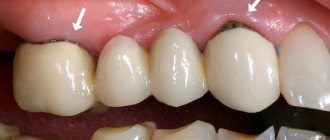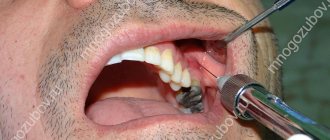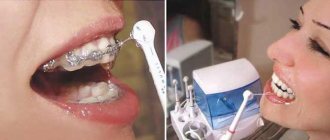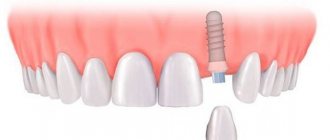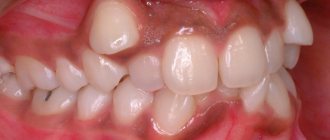Size of modern human teeth
Over more than two million years, the size of teeth gradually decreased due to the transition to eating soft and processed foods. The first transformations affected the fangs - in primates they were larger and more strongly advanced relative to the rest of the row. The interdental spaces have disappeared, the size of the front teeth has become smaller. Refusal of raw meat led to a decrease in the chewing load and a narrowing of the jaw, as a result of which there was no room left for the “eights”. Now wisdom teeth are considered atavism and are often subject to removal.
Surgical intervention
During the classic operation, the periodontal sulcus is excised. This procedure is associated with risks of postoperative complications, because the damaged anatomical formation is responsible for the immunological and protective function in the oral cavity.
Recently, surgical lengthening of teeth is performed using modernized technology, in which the gum margin is not removed. This type of intervention is considered the fastest and safest way to lengthen incisors.
Surgical lengthening is performed in 1 day. The duration of the procedure depends on the amount of work. To lengthen each element, a specialist takes on average up to 10 minutes.
1 week after surgery, temporary prostheses are installed. They are necessary for the formation of an anatomically correct gum contour.
Permanent structures are installed 3-5 months after surgery. This time is enough for the final formation of the gums. Orthodontic treatment lasts from 8–12 months.
The purpose of dental cystotomy and the expected result.
In this publication, we will calculate the cost of complex wisdom tooth removal.
Here https://zubovv.ru/hirurgiya/udalenie-zubov/atrofii-alveolyarnogo-otrostka.html all the most important things about alveolar process atrophy.
How are tooth sizes determined?
To determine the size of a person’s permanent teeth, the calculation tables of Wetzel and V.L. Ustimenko with average standards and permissible deviations are used. However, an experienced dentist is able to independently identify the anomaly during a visual examination or by applying the formula for the ratio of the height and width of the natural crown. During diagnosis, the specialist takes into account the patient’s face shape and height. For example, with a wide jaw, the size of teeth exceeding the norm is not a pathology.
To determine the size of the root canal, there are also tables that indicate the average distance from its apex to the cutting edge or cusp of the tooth surface. The longest is the root of the canines - about 26 millimeters, the root canal of the incisors is 21 - 23 millimeters, and the size of the roots of the chewing zone and premolar teeth ranges from 19 to 22 millimeters.
What methods are used for lengthening?
Modern dentistry offers various techniques for lengthening the crown of a tooth. Their selection is carried out on an individual basis depending on the patient’s indications.
| Method | Indications for use | How is it carried out? |
| Orthodontic | It is necessary to lengthen the crown of one tooth | Involves the use of braces, which must be worn for at least two years. |
| Orthopedic | Weared cutting edges of crowns, significant defects of decayed teeth, short teeth with the correct gingival contour. | It consists of building up with the use of veneers or crowns, which as a result raises the bite without involving the gingival area in the process. |
| Therapeutic | Chip of one tooth. | Provides for the restoration of the coronal part of the tooth by increasing the cutting edge using special composite materials. |
| Surgical | Gummy smile, the need to raise the gum level and give it the desired line. | An operation is performed to remove part of the bone and gum tissue and form the gingival contour of the desired shape. Depending on the clinical indications, bone resection, gingivoplasty or gingivectomy are performed. |
Teeth size for prosthetics
It is especially important to preserve and, if necessary, restore the natural size of teeth during prosthetics, so as not to disrupt the bite and the full functioning of the dental system. The size of the crown is selected by the dental technician, focusing on neighboring or teeth of the same name, monitoring the correct closure of the rows and adjusting the prosthesis during installation.
Determining the size of artificial teeth with complete edentia is carried out by measuring the distance between the corners of the mouth using a special ruler - it corresponds to the width of the six front teeth. And the segment from the edge of the gum to the smile line is equal to the height of the crown. For example, during implantation it is necessary to correctly calculate not only the parameters of the orthopedic design, but also the size of the dental implant. It should be equal in length to the real root, but the choice of titanium rod parameters depends largely on the volume of the jaw bone tissue.
If your teeth become longer...
Previously, periodontitis was considered the “hallmark” of aging. Today, this disease is also detected in young people. Therefore, it is so important to properly treat and prevent it from an early age. Periodontitis is an inflammation of the tissues surrounding the teeth. This disease causes gums to bleed, bad breath to appear, and teeth to appear longer.
At the same time, they become mobile and stagger, and if the disease develops, they begin to fall out. As a result, a person often loses straight, white, caries-free teeth.
Unfortunately, most patients see a doctor too late, when the process has become chronic and difficult to help. Many people simply do not notice a slight inflammation of the gums. But the disease does not even begin with him...
From plaque to stone
The first link in the development of periodontitis is the deposition of plaque. It can be compared to “putty”, which is composed of proteins, carbohydrates and pathogens and is firmly adhered to the tooth. Over time, plaque hardens and turns into tartar. And it irritates the gum mucosa and provokes inflammation.
Gradually, this process develops: swelling of the gums appears, the gingival papillae, which are located between the teeth, change. If treatment is not started, the ligaments that support the tooth in the gingival socket, and even the bone tissue of the jaw, suffer. At this stage, it is already difficult to do anything to save the teeth.
Genes plus gastritis
Heredity plays a significant role in the disease of periodontitis, but it is not only to blame. Cardiovascular disorders, nervous system disorders, diabetes mellitus, gastritis, stomach ulcers, and colitis contribute. Allergic and infectious diseases and lack of vitamins in food contribute to the development of the disease.
Periodontitis often makes itself felt during pregnancy: it is provoked by toxicosis. If you did not have bleeding gums while you were carrying your baby, then there is hope that at the genetic level you are not prone to the disease.
Under control!
It is completely impossible to cure periodontitis, but keeping the disease under control is absolutely necessary and for this you need to contact a periodontist.
The doctor first removes tartar to stop the disease process and prescribes comprehensive treatment. This may include taking antibiotics and vitamins, electrophoresis, hydromassage, rinsing gum pockets with medicinal solutions, or applying anti-inflammatory infusions.
But a lot depends on the patient himself: in order to consolidate the result after treatment, it is important to properly care for the oral cavity.
Clean clean
Patients with periodontitis should choose toothbrushes with hard bristles: they remove plaque better. At first, the bleeding of the gums may increase slightly, but there is no need to be afraid of this: gradually the gums will “get used” to the hard stubble. It is necessary to change the brush every month and a half, because during this time the bristles become soft.
You need to brush your teeth twice a day - before breakfast and before bed. The main movement when brushing is towards the cutting surfaces of the teeth. The procedure should take at least seven minutes. Increased attention should be paid to brushing your teeth before bed, especially for those people who suffer from diseases of the gastrointestinal tract.
At night, their saliva production slows down significantly, bacteria are not washed off from the surface of the tooth and actively multiply, which creates conditions for the further development of periodontitis.
In addition, it is advisable to clean the interdental spaces daily with dental floss. It is also useful to purchase a special brush for cleaning interdental spaces. You need to brush your teeth with it twice a week.
With periodontitis, the sensitivity of teeth to temperature changes, sour and sweet foods is increased. To reduce it, you need to choose a toothpaste containing fluoride and glycerophosphate. In this case, imported toothpastes are marked “sensitive”.
After using these pastes for a week or two, the discomfort should disappear, although not forever, but only for a while.
By the way
With medicinal pastes that contain extracts of pine needles, oak bark and substances that stop the inflammatory process in the gums, you can not only brush your teeth, but also do a massage. After thoroughly brushing your teeth, squeeze a little paste onto your finger and massage your gums in a circular motion.
Rinsing the mouth with infusions of calamus, aloe, oak bark, Kalanchoe, calendula, coltsfoot, plantain, yarrow, sage, and eucalyptus also helps.
Hydromassage is very useful. It can be done at home if you buy a nozzle for a water tap.
Source: medpulse.ru
Proportional ratio of teeth sizes
In most cases, specialists determine the proportions of a tooth by correlating its height and width. A result of about 0.75 is considered ideal. The most accurate diagnosis is carried out through the use of formulas.
- Gerlach's formula.
The method is based on the proportional ratio of the sizes of the front teeth and dental units of the chewing zone. The width of the crowns of the upper central incisors should correspond to the width of the four lower incisors. The canine, two premolars and one molar of both jaws are normally equal to each other. The width of the lateral part of the dentition is 10 mm greater than the width of the anterior segment. - Pon's formula.
The distance between the first premolars is equal to the sum of the widths of the four incisors multiplied by 100 and divided by 80, and the distance between the first molars is the sum of the widths of the four incisors multiplied by 100 and divided by 64. - Corkhouse formula.
The length of the segment from the midline to the first molar of the upper jaw should be 2 mm greater than the same distance on the lower jaw.
Timing of teeth lengthening
Depending on the technology used, the timing is different.
- Orthodontic vertical movement requires about 12-14 months, taking into account the retention phase of treatment.
- The orthopedic method will take about 2-3 weeks from the moment the impressions are taken. Here we mean prosthetics with crowns, ceramic inlays and veneers, as well as core inlays.
- The therapeutic method will require about one to two hours to create a restoration using photopolymers.
- The surgical method requires 15 minutes for each molar, premolar, incisor or canine. If, for example, the frontal area (canines and incisors) is lengthened, it will take about two hours.
Normal and deviations in tooth sizes
All dental units of the same name have approximately the same height and width, except for the central (medial) incisors. The size of the front teeth of the upper jaw is normally slightly larger than that of the lower jaw. The height of the crown of the upper central incisors varies from 9 to 12 millimeters, width - from 8 to 9 millimeters. The lower teeth are similar in height, but are about 5 millimeters wide. The size of a person's wisdom teeth does not differ from the parameters of other molars. The table below shows the average width of dental crowns in millimeters.
| Upper jaw | Lower jaw | |
| Medial incisor | 8.5 mm | 5.3 mm |
| Lateral incisor | 6.5 mm | 6 mm |
| Fang | 7.6 mm | 6.7 mm |
| First premolar | 6.7 mm | 6.8 mm |
| Second premolar | 6.4 mm | 7 mm |
| First molar | 9.4 mm | 10 mm |
| Second molar | 9.4 mm | 10.2 mm |
Anomalies in the size of human teeth can be congenital or acquired and are accompanied by malocclusion, impaired chewing functions and an unaesthetic appearance of a smile. The most common deviations are macrodentia and microdentia.
Causes and associated symptoms
There are only two reasons why one front tooth may be longer than the other:
| Tooth injury | Partial is easy to detect without the help of a specialist. In this case, one tooth suddenly becomes shorter, which is noticeable without special examination. At the same time, the lower (cutting) edge is uneven (zigzag, located at an angle, etc.), and its edge is very sharp. The child may complain of increased sensitivity in the “short” tooth or even pain - the severity of the symptoms depends on whether the fracture line affects the pulp or adjacent tissues. Tooth injury can occur under various circumstances - when a child tries to open a hard, hard package, during an accidental fall, etc. |
| Bite disorders | Anomalies in the growth of the jaws or parts of the facial skull, improper formation of tooth buds during intrauterine development, a number of embryonic pathologies, facial injuries and other circumstances can cause malocclusion. It is generally accepted that these are necessarily “crossed” teeth of the upper and lower rows, a protruding lower jaw or an “overhanging” upper jaw. But the listed criteria are not an incorrectly formed bite, but its signs. These signs also include different lengths of teeth - a circumstance indicating the inability of the teeth of the upper and lower jaws to close tightly, that is, the absence of a normal bite (from the word “bite”). |
If the front tooth has become longer for this reason, this is clearly and unmistakably indicated by the contour of the gum. In case of malocclusion, the gum of the shorter tooth is “raised” higher than the neighboring one. This is easy to assess during a routine examination, and if you measure the length of both teeth - long and short - their length will be the same. This means that a short or long tooth is, in fact, of normal length, it is only raised or lowered due to improper formation of the jaw in some area, and the difference in lengths is nothing more than a visual illusion.
But teeth of different sizes are rarely the only sign of an abnormal bite. As a rule, children with such dental deformities are more prone to periodontal diseases. They may also complain of headaches, increased fatigue, problems with nasal breathing and other non-dental disorders in the face or head. This is due to the fact that the dental system is part of the facial skull, and any violation of its functions leads to overstrain of the facial and chewing muscles, causes spasms of blood vessels, disruption of tissue nutrition, etc. As a result, symptoms develop that may seem unrelated to dental problems. problems.
Macrodentia
The tooth size exceeds the norm by more than 2 millimeters. Pathology occurs due to the fusion of two rudiments or the main and supernumerary teeth during the period of formation. The cause of macrodentia can be endocrine diseases, metabolic disorders or heredity. There are five types of pathology:
- localized - one or two teeth are significantly larger than the rest;
- generalized - the entire dentition differs in size from the other;
- isolated - enlargement of one medial incisor;
- absolute - the size of the teeth of both jaws exceeds the norm;
- relative - excessive growth of the upper or lower incisors.
Microdentia
The size of teeth in microdentia is less than anatomical standards. The list of reasons for deviation includes exposure to radiation, premature removal of a baby tooth, narrow jaw, and infectious diseases. There are several types of anomalies:
- isolated - a single violation affecting the lateral incisors;
- relative - the teeth are of normal size, but look smaller due to the enlarged jaw, as a result of which interdental spaces and diastema are formed;
- generalized - the defect covers a group of teeth.

